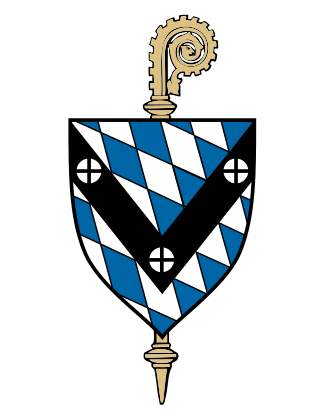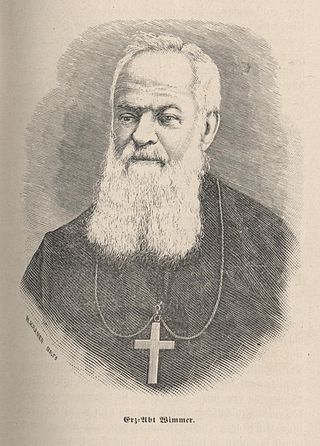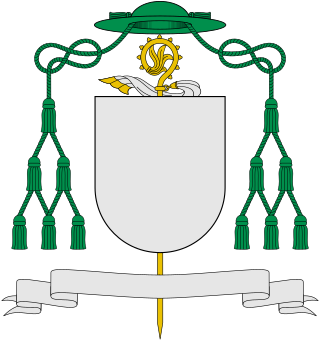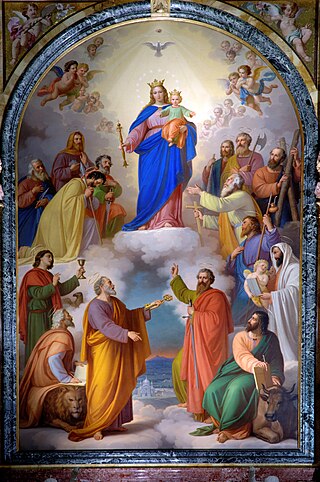
The Benedictines, officially the Order of Saint Benedict, are a mainly contemplative monastic order of the Catholic Church for men and for women who follow the Rule of Saint Benedict. Initiated in 529, they are the oldest of all the religious orders in the Latin Church. The male religious are also sometimes called the Black Monks, especially in English speaking countries, after the colour of their habits, although some, like the Olivetans, wear white. They were founded by Benedict of Nursia, a 6th-century Italian monk who laid the foundations of Benedictine monasticism through the formulation of his Rule. Benedict's sister, Scholastica, possibly his twin, also became a religious from an early age, but chose to live as a hermit. They retained a close relationship until her death.

Belmont is a small suburban city in Gaston County, North Carolina, United States, located about 9 miles (14 km) east of Gastonia. The population was 10,076 at the 2010 census. Once known as Garibaldi Station, it was named for the New York banker August Belmont. Belmont is home to Belmont Abbey College.

The Diocese of Raleigh is a Latin Church ecclesiastical territory, or diocese, of the Catholic Church that covers eastern North Carolina in the United States. It is a suffragan diocese in the ecclesiastical province of the metropolitan Archbishop of Atlanta.

The Diocese of Charlotte is a Latin Church ecclesiastical territory, or diocese, of the Catholic Church in western North Carolina in the United States. It is a suffragan diocese of the metropolitan Archdiocese of Atlanta.

Belmont Abbey College is a private, Catholic liberal arts college in Belmont, North Carolina. It was founded in 1876 by the Benedictine monks of Belmont Abbey. The college is affiliated with the Catholic Church and the Order of Saint Benedict. Belmont Abbey is the only college in North Carolina affiliated with the Catholic Church.

Downside Abbey is a Benedictine monastery in England and the senior community of the English Benedictine Congregation. Until 2019, the community had close links with Downside School, for the education of children aged 11 to 18. Both the abbey and the school are at Stratton-on-the-Fosse, between Westfield and Shepton Mallet in Somerset, South West England. In 2020, the monastic community of Downside Abbey was home to fifteen monks. In 2022, the community moved to Devon.

Saint Leo Abbey is an American-Cassinese monastery of Benedictine monks located in Saint Leo, Florida, United States.

Saint Vincent Archabbey is a Benedictine monastery in Westmoreland County, Pennsylvania in the city of Latrobe. A member of the American-Cassinese Congregation, it is the oldest Benedictine monastery in the United States and the largest in the Western Hemisphere. The shrine is dedicated to Saint Vincent de Paul.

Archabbot Boniface Wimmer, (1809–1887) was a German monk who in 1846 founded the first Benedictine monastery in the United States, Saint Vincent Archabbey in Latrobe, Pennsylvania, forty miles southeast of Pittsburgh.
Subiaco Abbey is an American Benedictine monastery located in the Arkansas River valley of Logan County, Arkansas, part of the Swiss-American Congregation of Benedictine monasteries. It is home to thirty-nine Benedictine monks. The abbey and the preparatory school it operates, Subiaco Academy, are major features of the town of Subiaco, Arkansas. It is named after the original Subiaco, Italy, where the first monastery founded by Saint Benedict was located.

A territorial abbey is a particular church of the Catholic Church comprising defined territory which is not part of a diocese but surrounds an abbey or monastery whose abbot or superior functions as ordinary for all Catholics and parishes in the territory. Such an abbot is called a territorial abbot or abbot nullius diœceseos. A territorial abbot thus differs from an ordinary abbot, who exercises authority only within the monastery's walls or to monks or canons who have taken their vows there. A territorial abbot is equivalent to a diocesan bishop in Catholic canon law.

Conception Abbey, site of the Basilica of the Immaculate Conception, is a monastery of the Swiss-American Congregation of the Benedictine Confederation. The monastery, founded by the Swiss Engelberg Abbey in 1873 in northwest Missouri's Nodaway County, was raised to a conventual priory in 1876 and elevated to an abbey in 1881. In 2021 the community numbered fifty-eight monks who celebrate the Eucharist and Liturgy of the Hours daily and who staff and administer Conception Seminary College, The Printery House, and the Abbey Guest Center. Monks also serve as parish priests and hospital chaplains in the Diocese of Kansas City-Saint Joseph and other dioceses. There is also a large postal facility attached to The Printery House, operated by lay employees, which includes package shipping and delivery facilities.

Martin Marty was a Swiss-born Benedictine missionary and Catholic bishop in the United States.

Mary, Help of Christians is a Catholic title of the Blessed Virgin Mary, based on a devotion now associated with a feast day of the General Roman Calendar on 24 May. The Catholic saint, John Chrysostom was the first person to use this Marian title in year 345 AD. Don Bosco also propagated the same devotion Mary, Help of Christians. It is also associated with the defense of Christian Europe, the north of Africa and the Middle East from non-Christian peoples during the Middle Ages.

Leo Haid was an American Benedictine abbot and Catholic bishop, who served as the abbot of the Abbey of Mary Help of Christians, in Belmont, North Carolina, from 1885 to 1924. He also served as vicar apostolic of North Carolina from 1888 to 1910 and territorial abbot from 1910 to 1924.
The Abbot Primate of the Order of St. Benedict serves as the elected representative of the Benedictine Confederation of monasteries in the Catholic Church. While normally possessing no authority over individual autonomous monasteries or congregations, he does serve as a liaison to the Vatican on behalf of the Benedictines, promotes unity among Benedictine monasteries and congregations, and represents Benedictines at religious gatherings throughout the world. He resides in Rome, Italy, at the Abbey of Sant'Anselmo all'Aventino which serves, because he is Abbot Primate, as the "Primatial Abbey of Sant'Anselmo." He appoints a Rector to oversee the College of Sant'Anselmo, serves as the "Grand Chancellor" of the Pontificio Ateneo Sant'Anselmo, and appoints a Rector to oversee the Church of Sant'Anselmo.

The American-Cassinese Congregation is a Catholic association of Benedictine monasteries founded in 1855. The monasteries of the congregation follow the monastic way of life as outlined by St. Benedict of Nursia in his early 6th century Rule of Saint Benedict. The congregation is one of 19 congregations in the Benedictine Confederation and includes 25 monasteries: 19 autonomous abbeys and 6 dependent priories, located across 15 states and Puerto Rico, as well as Brazil, Canada, Colombia, Mexico, and Taiwan.

Saint Anselm Abbey, located in Goffstown, New Hampshire, United States, is a Benedictine abbey composed of men living under the Rule of Saint Benedict within the Catholic Church. The abbey was founded in 1889 under the patronage of Saint Anselm of Canterbury, a Benedictine monk of Bec and former archbishop of Canterbury in England. The monks are involved in the operation of Saint Anselm College. The abbey is a member of the American-Cassinese Congregation of the Benedictine Confederation.

Rupert Seidenbusch was a German prelate of the Catholic Church. A Benedictine monk, he served as the first abbot of Saint John's Abbey (1866-1875) and the first Vicar Apostolic of Northern Minnesota (1875-1888).
The Benedictine Priory of Savannah is a Catholic monastery of Benedictine monks located in Savannah, Georgia. The priory was founded in 1877, and is a dependency of Saint Vincent Archabbey in Latrobe, Pennsylvania, and thereby belongs to the American-Cassinese Congregation. It currently operates the Benedictine Military School for boys.






















